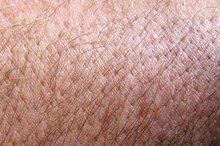Autoimmune Disorders That Cause Spider Veins
Spider veins smaller versions of varicose veins and appear red or blue near the surface of the skin 1. Spider veins are named for the pattern they portray, much like spider webs and are found on the legs or face. Essentially, this condition weakens valves in the veins, which causes blood to collect in the damaged area, the Cleveland Clinic notes 1. Several conditions contribute to the development of spider veins including autoimmune disorders, which weaken the natural ability of the body to protect itself from disease or antigens.
If you are experiencing serious medical symptoms, seek emergency treatment immediately.
Mixed Connective Tissue Disease
According to the Mayo Clinic, an uncommon autoimmune disease called mixed connective tissue disease causes spider veins 14. Mixed connective tissue disease is characterized by malaise, fatigue and pain in the muscles or joints as well as the hands 4. This condition is often mistaken for lupus, scleroderma or polymyositis, which are connective tissue diseases. Women are more likely to develop this condition prior to 40 years old. The weakened immune system results in connective tissue being attacked. Interrupted blood flow from having this condition further increases susceptibility of developing spider veins.
- According to the Mayo Clinic, an uncommon autoimmune disease called mixed connective tissue disease causes spider veins 1.
- Interrupted blood flow from having this condition further increases susceptibility of developing spider veins.
Autoimmune Hepatitis
What Causes Small Red Lines on the Face Under the Skin?
Learn More
Spider veins on the skin commonly occur as a symptom of autoimmune hepatitis 5. New York Presbyterian Hospital explains that this condition is a rare disease caused by the immune system attacking the liver 5. Autoimmune hepatitis is found primarily in women between 15 and 40 years old and factors causing this condition include viruses, certain drugs and possible toxins that trigger genetic susceptibility to autoimmune disorders 5. Treatment is significant after diagnosis to prevent progression and further liver damage. Untreated autoimmune hepatitis can lead to severe liver inflammation, liver failure or death 5.
Scleroderma and Ataxia-Telangiecstasia
The Robert Wood Johnson University Hospital indicates that the autoimmune disorder scleroderma causes spider veins 3. Scleroderma is characterized by abnormalities in the skin and blood vessels, which also increases occurrence of tingling, pain and numbness of the extremities. Scleroderma is more prevalent in females and factors contributing to the condition include heritability and environment. The disorder ataxia-telangiectasia impacts the immune system due to malfunctions of the lymphocytes, which defend the body against abnormal cells 2. The Merck Manual explains that this condition is hereditary and symptoms include dilation of the capillaries of the skin and eyes, resulting in spider veins on the eyeballs and ears. Additionally, this condition affects speech, muscle viability and can lead to paralysis or death.
Related Articles
References
- Cleveland Clinic: Varicose and Spider Veins
- Merck Manual: Ataxia-Telangiectasia
- Robert Wood Johnson University Hospital: Scleroderma
- Mayo Clinic: Mixed Connective Tissue Disease
- New York-Presbyterian: Autoimmune Hepatitis
- Piazza G. Varicose veins. Circulation. 2014;130(7):582-7. doi:10.1161/CIRCULATIONAHA.113.008331
- Heller JA, Evans NS. Varicose veins. Vasc Med. 2015;20(1):88-90. doi:10.1177/1358863X14566224
- U.S. Department of Health and Human Services, Office on Women's Health. Varicose veins and spider veins. Updated March 1, 2019.
- UCLA Gonda Venus Center: Symptoms and Diagnosis of Spider Veins
- WomensHealth.gov: Varicose Veins and Spider Veins Fact Sheet (2012).
Writer Bio
Aubri John has been a contributing researcher and writer to online physical and mental health oriented journals since 2005. John publishes online health and fitness articles that coincide with her licensed clinical skills in addictions, psychology and medical care. She has a master's degree in clinical social work and a Ph.D. in health psychology.









